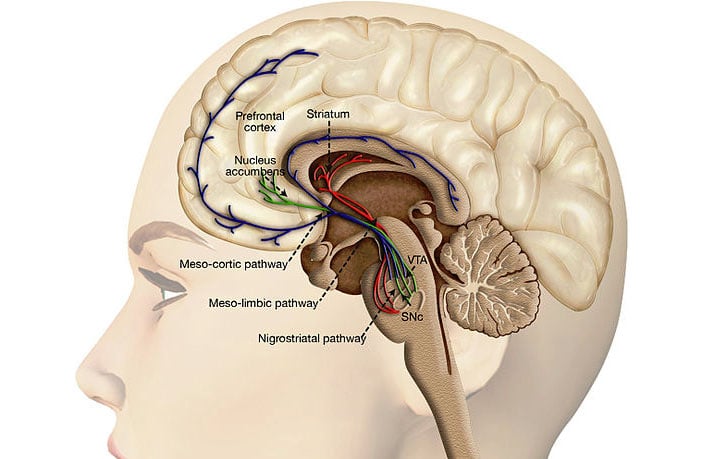Understanding The Epigenetics of Addiction
Addiction has been a pervasive problem that has plagued human history since we began recording it. Addiction is an issue we are still grappling with, even in developed nations. In the United States, nearly 21 million people have one or more addictions but only 10% of them receive treatment. [1] This costs the US economy north of $600 billion annually and has resulted in 700,000 deaths from overdose between 1999 and 2017.1 These are abysmal numbers. I will try to shed some light on what some of the causes of addiction are, as well as a brief overview of the neurochemistry of addiction.
Neurochemistry of Addiction
Before we try tackling the chemistry, lets introduce the key brain structure in addiction. Arguably, the most important part of the brain in addiction is the nucleus accumbens (NAc). This is the area of the brain that all drugs of abuse act on in some way.[2] All addictive drugs cause an burst of dopamine (DA) release in the NAc. 4 While this is the structure that will be referenced in this article, it should be known that many more areas of the brain play a role in addiction. A comprehensive review can be found here.[3]

Now to introduce one of the chemical messengers in addiction: FosB. FosB has been found to be expressed after exposure to nearly all drugs of abuse. 4 After repeated drug exposure, the levels of FosB only increase in the brain. As the levels continue to climb, a person’s sensitivity to natural rewards and drugs increases (as does the likely hood of voluntarily consuming more drugs). 4 FosB causes epigenetic changes in the brain, which increase the likelihood that someone will do drugs. This is one of the causes for the vicious cycle of drug abuse.
Causes of Addiction—Epigenetics
I will not try and explain every cause of addiction in this post for two reasons:
-
- It will be a very long list
- We don’t know what all of the causes are
However, I will provide a brief overview so we can better understand the causes of addiction, both social and molecular. A recent literature review finds 50% of variance in addiction is dues to genetic variation, while the other 50% is due to environmental variance[4] First, lets explore the genetic variation, but to do this we have to understand some basic epigenetics.
One of the most fundamental aspects of epigenetics, is the ability of a histone protein to become acetylated (i.e. stick a acetyl group onto a histone). Normally, the histone protein tightly binds DNA and prevents it’s transcription into mRNA. However, when the histone protein is acetylated, it loosens up and allows the DNA to be transcribed (see the following image for a visual).[5]

In addiction, histone acetylation occurs after acute exposure to stimulants like cocaine or amphetamine (meth). [6] Interestingly, these acetylations occur near promoters of c-fos and fosB in the nucleus accumbens (NAc). Earlier in this article, we mentioned how fosB is one of the molecular causes of promoting addiction. Now we know where it is coming from and why.
Conclusion
Drug addiction is still a problem in modern society. We have seen that epigenetic changes occur in the brain after exposure to drugs of abuse. This causes mental and physical changes to the person that increases their likelihood of continuing to consume drugs. Hopefully through studying the science behind what causes addiction, we can develop new treatments and improve on prevention strategies.
Sources
[1] https://www.addictioncenter.com/addiction/addiction-statistics/
[2] Scofield, M. D., Heinsbroek, J. A., Gipson, C. D., Kupchik, Y. M., Spencer, S., Smith, A. C., Roberts-Wolfe, D., & Kalivas, P. W. (2016). The Nucleus Accumbens: Mechanisms of Addiction across Drug Classes Reflect the Importance of Glutamate Homeostasis. Pharmacological reviews, 68(3), 816–871. https://doi.org/10.1124/pr.116.012484
[3] https://www.brainfacts.org/-/media/Brainfacts2/In-the-Lab/Animals-in-Research/Brain-Illustration-Reward.jpg?h=367&iar=0&w=650&hash=F19DD0579346B918C0126E49A1FB7B4D32967584
[4] Reul, J. M. (2014). Making memories of stressful events: A journey along epigenetic, gene transcription, and signaling pathways. Frontiers in Psychiatry, 5. https://doi.org/10.3389/fpsyt.2014.00005
[5] https://www.google.com/url?sa=i&url=https%3A%2F%2Ftheory.labster.com%2Fhistone-acetylation%2F&psig=AOvVaw3ybLsvI2s_wjYfMn32Uz1y&ust=1634161272580000&source=images&cd=vfe&ved=0CAsQjRxqFwoTCPjCv6TrxfMCFQAAAAAdAAAAABAT
[6] Renthal, W., & Nestler, E. J. (2009). Histone acetylation in drug addiction. Seminars in cell & developmental biology, 20(4), 387–394. https://doi.org/10.1016/j.semcdb.2009.01.005
